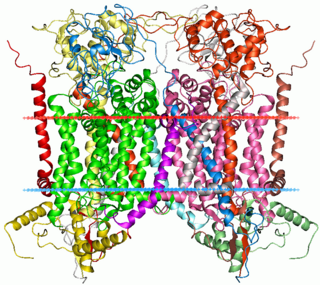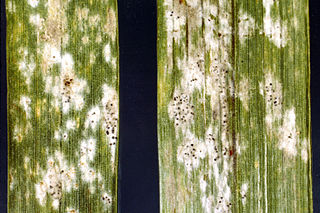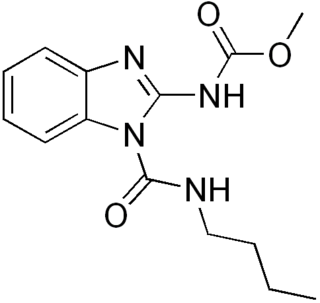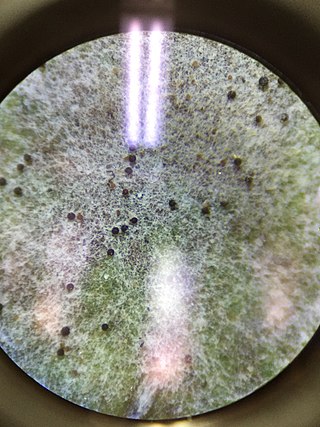Strobilurins are a group of natural products and their synthetic analogs. A number of strobilurins are used in agriculture as fungicides. They are part of the larger group of QoIs, which act to inhibit the respiratory chain at the level of Complex III.

Famoxadone is a fungicide to protect agricultural products against various fungal diseases on fruiting vegetables, tomatoes, potatoes, curcurbits, lettuce and grapes. It is used in combination with cymoxanil. Famoxadone is a QoI, albeit with a chemistry different from most QoIs. It is commonly used against Plasmopara viticola, Alternaria solani, Phytophthora infestans, and Septoria nodorum.
Fungicides are biocidal chemical compounds or biological organisms used to kill parasitic fungi or their spores. A fungistatic inhibits their growth. Fungi can cause serious damage in agriculture, resulting in critical losses of yield, quality, and profit. Fungicides are used both in agriculture and to fight fungal infections in animals. Chemicals used to control oomycetes, which are not fungi, are also referred to as fungicides, as oomycetes use the same mechanisms as fungi to infect plants. Fungicides can either be contact, translaminar or systemic. Contact fungicides are not taken up into the plant tissue and protect only the plant where the spray is deposited. Translaminar fungicides redistribute the fungicide from the upper, sprayed leaf surface to the lower, unsprayed surface. Systemic fungicides are taken up and redistributed through the xylem vessels. Few fungicides move to all parts of a plant. Some are locally systemic, and some move upwardly.

Powdery mildew is a fungal disease that affects a wide range of plants. Powdery mildew diseases are caused by many different species of ascomycete fungi in the order Erysiphales. Powdery mildew is one of the easier plant diseases to identify, as its symptoms are quite distinctive. Infected plants display white powdery spots on the leaves and stems. The lower leaves are the most affected, but the mildew can appear on any above-ground part of the plant. As the disease progresses, the spots get larger and denser as large numbers of asexual spores are formed, and the mildew may spread up and down the length of the plant.
The cereal grain wheat is subject to numerous wheat diseases, including bacterial, viral and fungal diseases, as well as parasitic infestations.

Cytochrome b within both molecular and cell biology, is a protein found in the mitochondria of eukaryotic cells. It functions as part of the electron transport chain and is the main subunit of transmembrane cytochrome bc1 and b6f complexes.

Blumeria graminis is a fungus that causes powdery mildew on grasses, including cereals. It is the only species in the genus Blumeria. It has also been called Erysiphe graminis and Oidium monilioides or Oidium tritici.

Benzimidazole fungicides are a class of fungicides including benomyl, carbendazim (MBC), thiophanate-methyl, thiabendazole and fuberidazole. They can control many ascomycetes and basidiomycetes, but not oomycetes. They are applied to cereals, fruits, vegetables and vines, and are also used in postharvest handling of crops.

Zymoseptoria tritici, synonyms Septoria tritici, Mycosphaerella graminicola, is a species of filamentous fungus, an ascomycete in the family Mycosphaerellaceae. It is a wheat plant pathogen causing septoria leaf blotch that is difficult to control due to resistance to multiple fungicides. The pathogen today causes one of the most important diseases of wheat.

Podosphaera pannosa is a plant pathogen. It produces a powdery mildew on members of the rose family.

Ascochyta is a genus of ascomycete fungi, containing several species that are pathogenic to plants, particularly cereal crops. The taxonomy of this genus is still incomplete. The genus was first described in 1830 by Marie-Anne Libert, who regarded the spores as minute asci and the cell contents as spherical spores. Numerous revisions to the members of the genus and its description were made for the next several years. Species that are plant pathogenic on cereals include, A. hordei, A. graminea, A. sorghi, A. tritici. Symptoms are usually elliptical spots that are initially chlorotic and later become a necrotic brown. Management includes fungicide applications and sanitation of diseased plant tissue debris.

Azoxystrobin is the ISO common name for an organic compound that is used as a fungicide. It is a broad spectrum systemic active ingredient widely used in agriculture to protect crops from fungal diseases. It was first marketed in 1996 using the brand name Amistar and by 1999 it had been registered in 48 countries on more than 50 crops. In the year 2000 it was announced that it had been granted UK Millennium product status.

Epoxiconazole is a fungicide active ingredient from the class of azoles developed to protect crops. In particular, the substance inhibits the metabolism of fungi cells infesting useful plants, and thereby prevents the growth of the mycelia. Epoxiconazole also limits the production of conidia (mitospores). Epoxiconazole was introduced to the market by BASF SE in 1993 and can be found in many products and product mixtures targeting a large number of pathogens in various crops. Crops are, for example, cereals, soybeans, banana, rice, coffee, turnips, and red as well as sugar beets.

Strobilurus tenacellus, commonly known as the pinecone cap, is a species of agaric fungus in the family Physalacriaceae. It is found in Asia and Europe, where it grows on the fallen cones of pine and spruce trees. The fruit bodies (mushrooms) are small, with convex to flat, reddish to brownish caps up to 15 mm (0.6 in) in diameter, set atop thin cylindrical stems up to 4–7.5 cm (1.6–3.0 in) long with a rooting base. A characteristic microscopic feature of the mushroom is the sharp, thin-walled cystidia found on the stipe, gills, and cap. The mushrooms, sometimes described as edible, are too small to be of culinary interest. The fungus releases compounds called strobilurins that suppress the growth and development of other fungi. Derivatives of these compounds are used as an important class of agricultural fungicides.

Oudemansin A is a natural product first isolated from the basidiomycete fungus Oudemansiella mucida. Its chemical structure was determined by X-ray crystallography in 1979 and absolute stereochemistry by total synthesis. Two closely related derivatives, oudemansin B and X have also been isolated from other basidiomycetes. They are all biologically active against many filamentous fungi and yeasts but with insufficient potency and stability to become useful commercial products. However, their discovery, together with the strobilurins led to agricultural fungicides including azoxystrobin with the same mechanism of action.

Fluxapyroxad is a broad-spectrum pyrazole-carboxamide fungicide used on a large variety of commercial crops. It stunts fungus growth by inhibiting the succinate dehydrogenase (SQR) enzyme. Application of fluxapyroxad helps prevent many wilts and other fungal infections from taking hold. As with other systemic pesticides that have a long chemical half-life, there are concerns about keeping fluxapyroxad out of the groundwater, especially when combined with pyraclostrobin. There is also concern that some fungi may develop resistance to fluxapyroxad.

Cyproconazole is an agricultural fungicide of the class of azoles, used on cereal crops, coffee, sugar beet, fruit trees and grapes, on sod farms and golf courses and on wood as a preservative. It was introduced to the market by then Sandoz in 1994.

Powdery mildew of lilac, or Erysiphe syringae is a fungal pathogen of lilacs.

Metyltetraprole is a quinone outside inhibitor fungicide sold under the brand name Pavecto by its inventor, Sumitomo Chemical. It is the only tetrazolinone fungicide and the only one in the Fungicide Resistance Action Committee's subgroup 11A.















